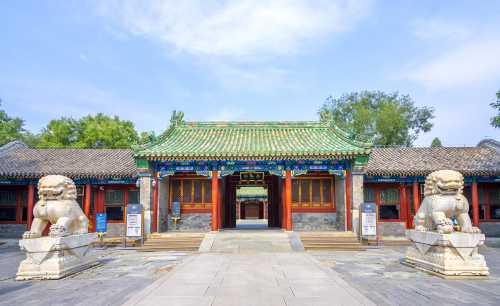Popular Trip Moments
From palace whispers to bamboo shadows: tracing the soul of Qing Beijing | China Numismatic Museum: A Journey Through the History of Chinese Currency | 👜 Stay & Shop in Style: Rosewood Beijing ✨ | 👜 Luxury Stay & Shop: The Peninsula :Beijing shopping 🛍️ ✨ | ✨ Staying at The Peninsula Beijing for Shopping 🛍️ | ✨ China World Mall, Beijing 🛍️ | Dinosaurs, nice exhibitions in Natural History Museum of China | Masterpieces in the National Art Museum of China | 🇨🇳✨Wangfujing Wonderland: Beijing’s Shoppers’ Paradise & Street Food Heaven! 🛍️🍢 | 🇨🇳✨ Sanlitun Taikooli: Where Fashion Meets Fun in Beijing! 🛍️🎨 | 🇨🇳✨ Wangfujing Wonders: Beijing’s Shopping & Street Food Paradise! 🛍️🍢 | 🇨🇳✨ Wangfujing Street Magic: Where Shopping Meets Street Food! 🛍️🍢 | 4 Days of Beijing Buzz & Tianjin Thrills 🏯🚄 | A day trip from Beijing! You can't resist a trip to Tianjin~ | Day 1 of 3 nights and 5 days in Beijing, China!!! (including Michelin restaurants) | The Forbidden City | The Ancient Terraced Fields of Weizishui Village | A hidden gem courtyard hotel in Beijing's hutongs | Escape to a Kid-Friendly Private Courtyard Villa with Unlimited Stays in Beijing | Dreaming in the Wild: A Fairytale Encounter | A man at forty is in his prime, and now he's using Cellcosmet too. | 1h escape from the city! A little Jiangnan hidden in Haidian, perfect for two | Beijing's first choice for summer water play with children 🌊 Maya Beach Water Park Guide✨ | Beijing to Bangkok Budget Airlines: A True Guide to Affordable Travel | Stay in Sanlitun for 200 RMB per person! | I finally discovered this hutong hotel in Beijing—so comfortable! | Beijing Backpacking: Unveiling the Ancient Capital’s Hidden Gems | In the heart of the capital, indulge in luxurious elegance | My first time staying at such a luxurious hotel was absolutely incredible!
Trending Travelogues
Recommended Attractions at Popular Destinations
Attraction near Bangkok | Attraction near Manila | Attraction near Tokyo | Attraction near Taipei | Attraction near Hong Kong | Attraction near Seoul | Attraction near Kuala Lumpur | Attraction near Los Angeles | Attraction near Shanghai | Attraction near New York | Attraction near Shenzhen | Attraction near Osaka | Attraction near Singapore | Attraction near London | Attraction near Guangzhou | Attraction near San Francisco | Attraction near Beijing | Attraction near Macau | Attraction near Bali | Attraction near Jakarta | Attraction near Paris | Attraction near Ho Chi Minh City | Attraction near Istanbul | Attraction near Phuket | Attraction near Chicago | Attraction near Seattle | Attraction near Toronto | Attraction near Orlando | Attraction near Cebu | Attraction near Chiang Mai
Popular Attractions
Lingyin Feilai Peak Scenic Area | Safari Park Shenzhen | Pattaya Elephant Village | KL Bird Park | Palm Jumeirah Monorail | WTCAD - World Trade Center Abu Dhabi | Schönbrunn Palace | Edinburgh Castle | Royal Mile | Burj Khalifa | Plaza de Espana | Disneyland Paris | Beijing Expo Park | Arthur's Seat | Canyon Pumice Forest | Shangrila-Dynamic Yunnan | Berlin Wall Memorial | Happy Magic Watercube | Markandeshwar New Temple | garden oochwa | La Treille Vente Directe / La Treille Farm and Gîte | Parròquia Sant Antoni Maria Claret | Maillezais Garden | Situ Keroncong - Cipelah | Igreja Universal | GPdI Ekklesia Boyong Pante | LKS Orzeł Trąbki Wielkie | Visitor Center of the "Mouth of the Isonzo" Regional Nature Reserve | Mengalum Island | "Nandgram Godham" - Cow & Agri Tourism
Popular Restaurants in Beijing
The View 3912 | LA CHANSONNIÈRE | IL RISTORANTE - NIKO ROMITO | Fu Chun Ju | CAI YI XUAN | Siji Minfu Roast Duck (Gugong) | ZIJIN MANSION | MIO | Café Zi | Rive Gauche | China Grill | Daccapo | JING RESTAURANT | MENKUANGHUTONGBAINIANLUZHU | Gastro Esthetics at DaDong | NIU JIE JU BAO YUAN | Made In China | SHENG YONG XING ROAST DUCK RESTAURANT | King's Joy | AZUR | Lobby Lounge at Regent Beijing | Summer Palace @ China World Hotel | THE HOUSE OF RONG | Char bar&grill | Grill 79 | 钓鱼台国宾馆芳菲苑 | Yun Summer Lounge | Redwall 1939 | JINGJI ARISTOCRAT CUISINE BY RONG | LU YU
Popular Ranked Lists
Popular Premium Hotels in Sylt Ost | Popular Premium Hotels in Pizzo | Popular Must-Visit Restaurants in Phuket | Popular Must-Visit Restaurants in Munich | Popular Premium Hotels in Durango | Popular Premium Hotels in Hinderwell | Top 6 Best Things to Do in Hezhou | Popular Must-Visit Restaurants in Bangkok | Top 4 Best Things to Do in Yingkou | Popular Best Things to Do in Nanchong | Popular Must-Visit Restaurants in Santorini | Popular Premium Hotels in Taunggyi | Popular Must-Visit Restaurants in Athens | Popular Premium Hotels in Mbabane | Popular Best Things to Do in Luanping | Popular Must-Visit Restaurants in Fukuoka | Popular Premium Hotels in Valle de Bravo | Popular Must-Visit Restaurants in London | Popular Luxury Hotels in Tegernsee Lake | Top 10 Must-Visit Restaurants in Bad Ischl | Popular Must-Visit Restaurants in Sydney | Popular Premium Hotels in Scarborough District | Popular Premium Hotels in Karaganda | Popular Premium Hotels in Cheongju | Popular Premium Hotels in Otocec | Popular Must-Visit Restaurants in Paris | Popular Must-Visit Restaurants in Melbourne | Top 3 Local Restaurants in Xinyuan | Popular Best Things to Do in Ninghai | Popular Premium Hotels in State of Mexico
Payment Methods
Our Partners
Copyright © 2025 Trip.com Travel Singapore Pte. Ltd. All rights reserved
Site Operator: Trip.com Travel Singapore Pte. Ltd.
Site Operator: Trip.com Travel Singapore Pte. Ltd.





















